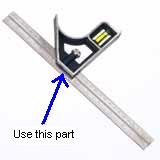Set up blocks and 1,2,3 blocks are two different items.
Set up blocks are used for setting clearences between straightedges and sawblades or drill bits to ensure a consistant spacing for cutting metal or wood or plastic to a specified width.They are also used to ensure that a drilled hole is a consistant distance from the edge of the stock.
1,2,3 blocks primary function was to keep clamping devises level when anchoring dies and fixtures in a machine.They get their name from the fact that they are 1"x2" x3" insize and are machined to very close tolerences.They are also used as stop blocks ,and have several threaded holes used to hold threaded rods for attaching lineclamps for collant hoses and other things.
Now I use my 1,2,3 blocks to steady the walls in a building I am bashing or scratchbuilding.By the way these blocks come in other sizes also.I have seen 2,4,6 and 4,8,12 blocks.The 2,4,6 blocks could be of some use for modeling but the bigger blocks IMO would mostly just get in the way.I believe there other sizes beyond these.
Ok,that's it for Machine Shop 101 today,class dismissed




